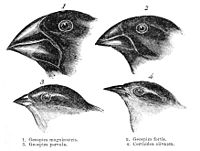
Photo from wikipedia
Species interactions such as mimicry can promote trait convergence but disentangling this effect from those of shared ecology, evolutionary history, and niche conservatism is often challenging. Here by focusing on… Click to show full abstract
Species interactions such as mimicry can promote trait convergence but disentangling this effect from those of shared ecology, evolutionary history, and niche conservatism is often challenging. Here by focusing on wing colour pattern variation within and between three butterfly species living in sympatry in a large proportion of their range, we tested the effect of species interactions on trait diversification. These butterflies display a conspicuous iridescent blue coloration on the dorsal side of their wings and a cryptic brownish colour on the ventral side. Combined with an erratic and fast flight, these colour patterns increase the difficulty of capture by predators and contribute to the high escape abilities of these butterflies. We hypothesize that, beyond their direct contribution to predator escape, these wing patterns can be used as signals of escape abilities by predators, resulting in positive frequency‐dependent selection favouring convergence in wing pattern in sympatry. To test this hypothesis, we quantified dorsal wing pattern variations of 723 butterflies from the three species sampled throughout their distribution, including sympatric and allopatric situations and compared the phenotypic distances between species, sex and localities. We detected a significant effect of localities on colour pattern, and higher inter‐specific resemblance in sympatry as compared to allopatry, consistent with the hypothesis of local convergence of wing patterns. Our results provide support to the existence of escape mimicry in the wild and stress the importance of estimating trait variation within species to understand trait variation between species, and to a larger extent, trait diversification at the macro‐evolutionary scale.
Journal Title: Journal of Evolutionary Biology
Year Published: 2020
Link to full text (if available)
Share on Social Media: Sign Up to like & get
recommendations!